|
After
the opening of the railway section between Steinamanger and Pinkafeld in
December, 1888, when every year more and more guests were visiting the spa town
of Bad Tatzmannsdorf, influential circles began working towards a railway
connection for Bad Tatzmannsdorf.
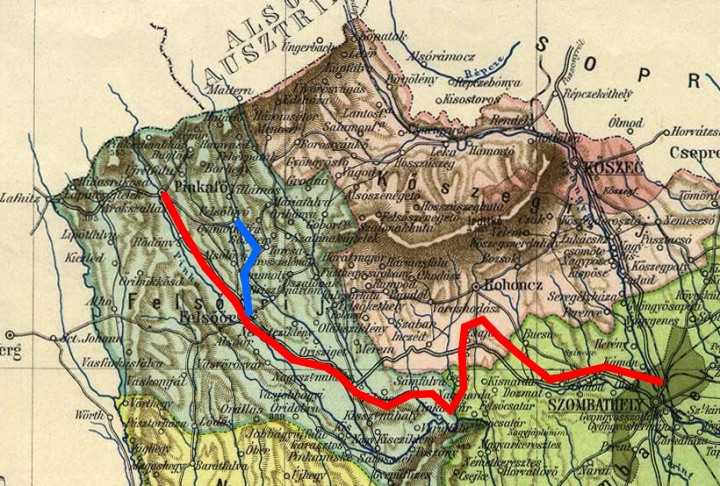
The
vehicle owner Johann Ochsenhofer from Oberwart, who probably figured that at
that time a railway to Tatzmannsdorf would not be built so quickly, took
advantage of the ever-increasing flow of tourists in 1892 and bought a new
omnibus for the ride to Tarcsa (the Hungarian name of Tatzmannsdorf). This
omnibus corresponded in every aspect, both in elegance and convenience, to its
time. It was big and spacious and built according to the specifications of the
Viennese summer tramway wagons.
In 1896, Adolf Stern from Szombathely initially requested permission for
preliminary works for a local steam-driven railway from the station
Großpetersdorf, of the Szombathely-Pinkafeld railway, via Dornau, Neumarkt,
Altschlaining, Stadtschlaining and Bergwerk to Tatzmannsdorf. Alternatively, he
thought of a train from Oberwart to Tatzmannsdorf. In May, 1896, the permission
was granted by the Secretary of Trade, and extended by one year in 1897.
However, for financial reasons, Adolf Stern soon went for the shorter track from
Oberwart, and opted for an extension until Oberschützen to extend it further
later on towards the border in an appropriate way. For this he also got the
permission. The "technical soul” of the project was engineer Ludwig
Fränkl, who had already completed successfully various other railway
constructions. Soon the track was displayed. Starting from the station Oberwart,
it led over the hill Jesusberg, through the Zicken valley, passed the gypsies of
Unterschützen, rising to the hill between Tatzmannsdorf and Oberschützen until
the cemetery of Oberschützen. Unterschützen, Tatzmannsdorf, and Oberschützen
were designated as stations.
The funding of the construction started with the offering of common stock. The
municipalities along the route were invited to take shares. Initially, the
negotiations with the municipalities were quite satisfactory. Some private
persons also bought bigger shares, e.g., Camillo Bennfilier from Unterschützen
(5,000 fl.). The municipality of Oberschützen was even willing to buy shares
worth 10,000 florins, if they got a rail connection. Stern warmly welcomed the
intention of the management of the antimony mine in Schlaining to have their
goods transported by train via Tatzmannsdorf in case of realization of the
project. Adolf Stern also sought support at the Comitatus (county) and asked for
16,000 florins.
On December 20, 1897 the revision of the track Oberwart - Bad Tatzmannsdorf -
Oberschützen took place.
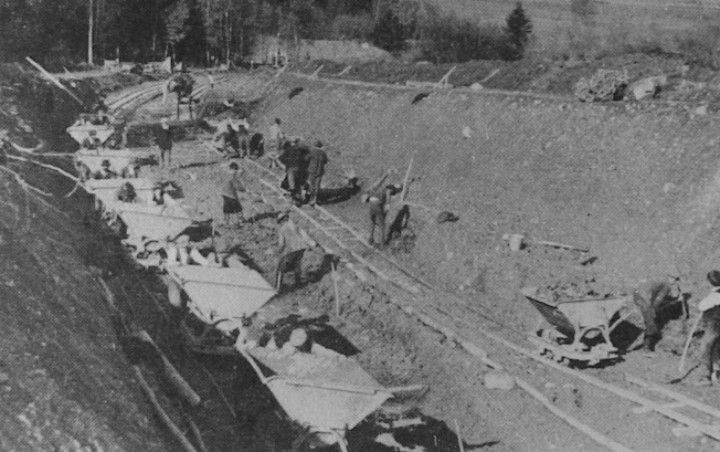
For
January 26, 1898, the Secretary of Trade arranged the administrative inspection,
which was led by ministerial secretary Dr. Andor Barthos of the Ministry of
Trade. There were also representatives of the Ministry of Agriculture, the
Comitatus and the Management Committee, the Hungarian State Railways, the
Steinamanger-Pinkafeld Lokalbahn AG (railway company), the concessionaires Adolf
Stern and engineer Ludwig Fränkl. Also present were the spa doctor of
Tatzmannsdorf, Dr. Aladar Rhorer, the Protestant pastor Julius Stettner, Johann
Ebenspanger of the educational institute of Oberschützen and chief magistrate
Geisa Herbst. The negotiation lasted from 11 am to 2.30 pm, until the entire
route had been thoroughly discussed, especially the bridges, culverts, street
crossings, and connecting paths. After completion of the revision, which had
taken place alongside "very keen interest among the population of the area",
the entire party had been invited by the concessionaires to a “frugal dinner”
in the beautifully decorated locations of the Tatzmannsdorf inn. All were
hopeful of being able to finish this railway in the course of 1898. They also
believed that there would soon be a connection towards Aspang or Edlitz.
On July 8, 1898 the concession for the construction of the railway was
negotiated in the Ministry of Finance in Budapest. The negotiations went well so
the construction work could start in summer. Stern and Fränkl wanted to finish
the sub-base until the end of the year. However, the opening event (Easter 1899)
had already been delayed a little bit. Because the financing was not secured,
Stern asked the Comitatus for a raise of the granted amount of 12,000 florins to
the 16,000 florins he had applied for in 1897. On July 29 and 30, however, the
permanent committee of the Comitatus decided not to grant this additional
subsidy.
However, the Board of Oberwart decided in July 1898 to subscribe for common
shares, but didn’t want to spend more than 1,000 florins.
Construction was not started. In December, 1898, engineers were back on the
track to define the definitive route, as it was said. In the beginning of 1899,
the Secretary of Trade approved a notable state contribution and asked the
concessionaire to give the deposit.
Although the last revision of the track took place in March, the necessary money
had still not been raised. The concessionaire, therefore, held a meeting:
"In consequence of the Decree No. 63.966-V/98 of February 22, 1899 of His
Excellency the Royal Hungarian Secretary of Trade in the matter of the
Oberwart-Tatzmannsdorf-Oberschützen neighbouring railway, there is need for a
counsel prior to the start of construction of the railway, which is why we have
the honor to invite you to a conference about this matter on March 19, Sunday
afternoon at 1 in the Town Hall of Oberschützen”.
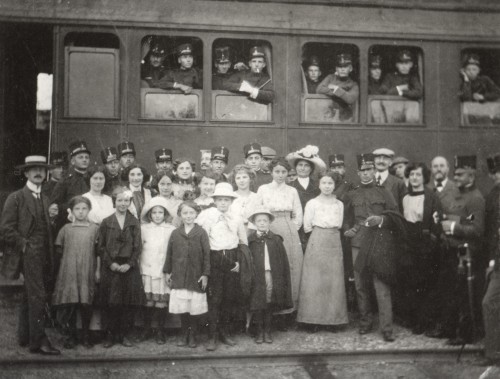 Bashful Stern did not mention that he still needed money. The conference was
well attended. The chief magistrate Geisa Herbst, mine director Karl Rochata (antimony
mine) who was director of the spa town Tatzmannsdorf, Dr. Aladar Rhorer who was
a representative of the privateer Camillo Bermüller from Unterschützen,
principals of the municipality, and other interested people came. Engineer
Fränkl reported on the work done so far. He informed that for the railway
construction the Comitatus provided 16,000 florins and the Government 30,000
florins. Regarding the operation of the railway a favourable agreement was made
with the Hungarian National Railway, the Ministry had approved the plans and
cost estimates and issued authorization for the payment of the deposit - once
the remaining 12,000 florins worth of common shares was placed.
Bashful Stern did not mention that he still needed money. The conference was
well attended. The chief magistrate Geisa Herbst, mine director Karl Rochata (antimony
mine) who was director of the spa town Tatzmannsdorf, Dr. Aladar Rhorer who was
a representative of the privateer Camillo Bermüller from Unterschützen,
principals of the municipality, and other interested people came. Engineer
Fränkl reported on the work done so far. He informed that for the railway
construction the Comitatus provided 16,000 florins and the Government 30,000
florins. Regarding the operation of the railway a favourable agreement was made
with the Hungarian National Railway, the Ministry had approved the plans and
cost estimates and issued authorization for the payment of the deposit - once
the remaining 12,000 florins worth of common shares was placed.
They were, however, not to be found. "The question of the “Vizinalbahn”
(neigboring railway) … seemingly rests, but quietly they are working
diligently on the financing of the railway," announced Oberwart’s Sunday
newspaper on July 2, 1899.
The license for preliminary work on this route had to be extended for another
year in July for the concessionaires Adolf Stern and Engineer Ludwig Fränkl.
In November, 1899, the engineers Wilhelm Brenner and Szarvas came from Budapest
to begin with the local recordings, which they presented the Ministry of Trade
during the winter. Still it was hoped to begin construction at least at the
beginning of the next spring, in 1900.
"Good things need time", recorded Oberwart’s Sunday newspaper in
April 1900 and announced that its reporter had read with his own eyes in a
notarial deed, resting at the local administration of Oberschützen, that
Engineer Ludwig Fränkl (now Louis Fábián) from Budapest had bought all claims
from his co-concessionaire Stern and therefore is now since February 9, 1899 the
sole concessionaire of the projected “Vizinalbahn” Oberwart - Tatzmannsdorf
- Oberschützen. Engineer Fábián certainly was an excellent expert - he had
also projected the Sopron - Bratislava railway - but he also lacked the
necessary funds. The financial difficulties were justified by the reluctance of
banks due to the recent increase of money costs. The construction, however,
would be imminent.
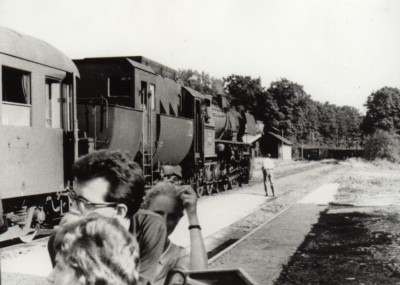 After all, the Comitatus decided upon a contribution of a total of 16,000
florins according to the concessionaire’s request of 1898. This decision was
approved by the government of Budapest in spring, 1900. However, as
"Eisenburg" (the Comitatus) announced, the “absconding
concessionaire Adolf Stern” could not be informed. Apparently, the Ministry
did not know yet, that, since February, 1899, Engineer Fábián was
concessionaire.
After all, the Comitatus decided upon a contribution of a total of 16,000
florins according to the concessionaire’s request of 1898. This decision was
approved by the government of Budapest in spring, 1900. However, as
"Eisenburg" (the Comitatus) announced, the “absconding
concessionaire Adolf Stern” could not be informed. Apparently, the Ministry
did not know yet, that, since February, 1899, Engineer Fábián was
concessionaire.
In June Engineer Fábián’s license for preliminary work on the route was
extended for another year. Furthermore he got from the Secretary of Trade a
license for preliminary work on a continuing route for a local railway going via
Willersdorf until the border.
Finally, Engineer Fábián was able to deposit the 30,000 krones (15,000 florins)
bail set by the government in the Central Treasury in Budapest. About this,
Fábián informed the municipality of Oberwart and stated that the construction,
after clarification of some issues, would presumably start in spring, 1902.
The government had also decided that the operation of this railway would be
undertaken by the Hungarian national railways. This ensured that when creating
the schedule, the children from Oberwart in Oberschützen would be considered
enough to be able to return home in time for lunch.
The political inspection for the extension took place on May 22nd, 1902 in Bad
Tatzmannsdorf. At the following celebratory banquet in the restaurant “Josef
Weghofer,” the concessionaire announced that the new railway would be
available for traffic until Mid-October or, at the longest, until Mid-November.
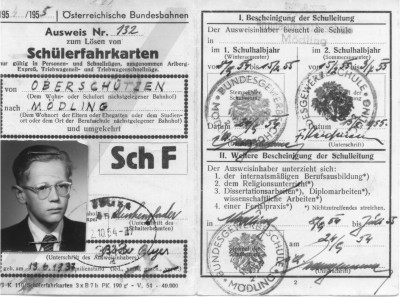 On July 3rd, all landowners whose realty would be crossed by the future railway
assembled in the Inn “Zum Wilden Mann” in Oberwart. The persons appearing
were not edified by the blissfulness of the concessionary speaker, the advocate
Dr. Edmund Viola, as they did not understand the necessity of the railway. They
reckoned the railway would only bring harm to Oberwart. The best land would be
fragmented by the construction, which is why they would have to charge a higher
transfer fee. After an extended debate, a minimum fee of 60 kreuzers per squared
fathom was decided. The peasants were satisfied and decided to sell the land.
On July 3rd, all landowners whose realty would be crossed by the future railway
assembled in the Inn “Zum Wilden Mann” in Oberwart. The persons appearing
were not edified by the blissfulness of the concessionary speaker, the advocate
Dr. Edmund Viola, as they did not understand the necessity of the railway. They
reckoned the railway would only bring harm to Oberwart. The best land would be
fragmented by the construction, which is why they would have to charge a higher
transfer fee. After an extended debate, a minimum fee of 60 kreuzers per squared
fathom was decided. The peasants were satisfied and decided to sell the land.
A few days later, all landowners whose property would be crossed by the railway
were informed with a drumroll that their fields and meadows were to be scythed
as the construction was to begin soon.
After the authorization of the construction of the railway was confirmed by His
Majesty, a ground-breaking ceremony was held on the 18th June 1902. In front of
a big audience, construction engineer Wilhelm Brenner gave special thanks to
chief engineer Ludwig Fábián and the popular spa director Dr. Aladár Rhorer,
who followed their goal with great effort and endurance. After the workers were
offered breakfast, the real construction began. At the end of the week, about
200 workers were employed.
As the construction had begun before a permit had been obtained, Fábián urged
the authorities to issue their approval. The committee was therefore informed
telegraphically by the Secretary of Trade that a provisional concession had been
given for the task.
On June 26th, 1902, the "Felsö-Eör-Tarcsa-Felsö-Lövöi helyi érdekü
vasút részvénytársaság" (Oberwart-Tatzmannsdorf-Oberschützen local
railway stock company) was founded. It was first based in Budapest VIII
József-körút 19, later in Nádor utca 16. The capital stock was K 835.400 in
1236 common stock á K 200 = K 247.200 and 2.941 priority stock á K 200 = K
588.200. The priority stock had a prior claim on 5 % dividend, in case with the
right of subsequent payment. The stock clearance was carried out through a
raffle. The concession document was drawn up on June 21st, 1902. The time frame
was 90 years.
The people voted for chief executives were Theodor Barthos Jr., Johann
Ebenspanger, Ludwig Fábián. Dr. Adalbert Fináczy, Dr. Elias Fränkl, Dr.
Isidor Käufer, Dr. Eduard Környei Jr., Dr. Adalbert Molnár, Dr. Koloman
Olgany, Dr. Aladár Rhorer and Dr. Edmund Viola.
The earthwork progressed well, but was slightly constrained by continuing rain.
Work had also started at the train station at Bad Tatzmanndorf. In the middle of
August, workers were busy digging the well. As the main well was 21 meters deep,
there were several complications. In Oberschützen, water could not even be
found at a depth of 25 meters.
In the middle of December, 1902, the track as far as Oberschützen was put in
place and workers were finalizing the station building.
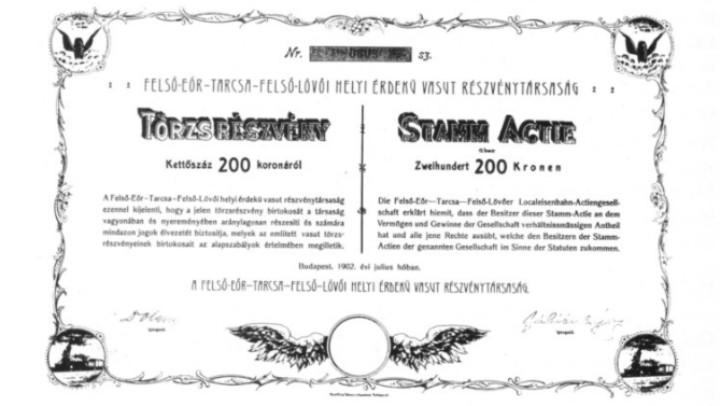
Common stock of 200
krones dated July 1906 of the Oberwart – Tatzmannsdorf – Oberschützen Local
Railway Inc. On the right the document is signed by railway engineer Lajos
(Ludwig) Fábián. (Collection: Municipality of Pinkafeld)
Ceremonial opening
The railway from
Oberwart to Bad Tatzmannsdorf was finished in the beginning of 1903. The
official commission, which was sent by the general management of the Hungarian
State Railway in Szombathely (led by Gustav v. Pottyondy), had already made the
entire route the subject of a close inspection, whereas the operation manager
flatteringly spoke out on “solidity and a good completion of the construction”.
On March 5th the route had been inspected again by a commission sent by the
ministry and led by chief engineer Korányi. On March 9th, the final acceptance
of the construction work was finished. As the route was found to be in a good
condition, the opening had nothing in its way. Furthermore, it was decided that
four trains should operate from Oberwart to Oberschützen and return.
The layout of the line from Tatzmannsdorf to Edlitz was to start in May.
Authoritative circles still believed that the completion of the new route would
occur within a short time.
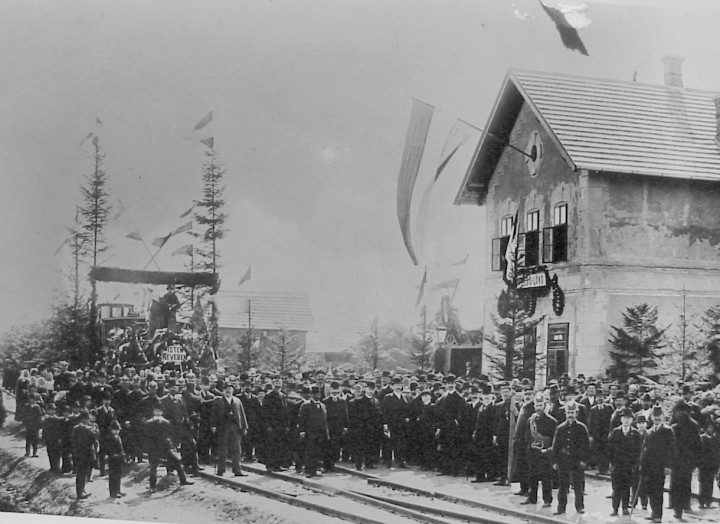
The technical
police inspection, which was combined with the ceremonial opening of the newly
built railway route, was arranged for March 24th, 1903, and a day later, on
March 25th, it was to be given over to public transport.
The hard-bitten endurance and the tireless commitment of the concessionaires,
Dr. Aladár Rhorer and engineer Ludwig Fábián, the sacrifices of the committal
family Batthyány, the community of Oberschützen, and many other interested
parties made it possible that the new railway could be opened. On the day of the
opening on March 24th, the train from Szombathely with the guests of honour on
board arrived at 9 a.m. in Oberwart where, just as at other formal occasions, a
large part of the population was listening to the speeches. The commission that
was on board carried out the required inspection and drove from Oberschützen
back to Bad Tatsmannsdorf with the guests of honour, where the gala dinner took
place in the big hall of the “Hotel zur Krone”.
On October 27th and 28th, 1903, the final acceptance of construction work of the
railway took place. Therewith, the operation was definitively taken over by the
state.
On the agenda of the general assembly that took place on June 6th, 1904 in the
Hungarian Agrobank in Budapest were the statement of financial condition of
1903, the usage of the profit (8,804.59 K), and also the election of three
executive members. Dr. Adalbert Fináczy, Dr. Koloman Olgany and Dr. Aladár
Rhorer had dropped out.
Timetable (from May 1st, 1905)

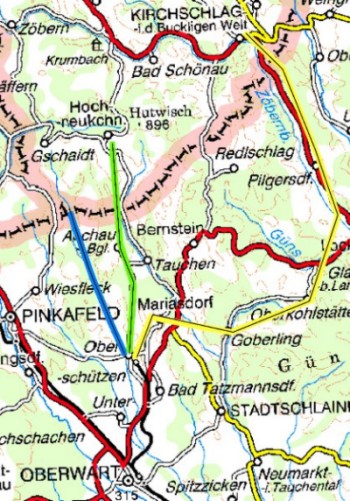 Still before the opening of the new railway, a group of prospective clients
ensured the ways for expansion of the construction. The Secretary of Trade gave
the approval to great land owner Eduard Allmásy, manager Dr. Aladár Rhorer and
engineer Ludwig Fábián as members of the consortium for a preliminary work for
a local railway from the train station in Oberschützen via Tauchen, Aschau
towards Hochneukirchen until the national border, possibly towards Mariasdorf,
Bergwerk, Goberling, Unterkohlstätten, Bernstein, Langeck, Lockenhaus, Deutsch
Gerisdorf, Bubendorf, Pilgersdorf in Zöberntal, towards Kirchschlag until the
normal-tracked local steam railway that leads to the border.
Still before the opening of the new railway, a group of prospective clients
ensured the ways for expansion of the construction. The Secretary of Trade gave
the approval to great land owner Eduard Allmásy, manager Dr. Aladár Rhorer and
engineer Ludwig Fábián as members of the consortium for a preliminary work for
a local railway from the train station in Oberschützen via Tauchen, Aschau
towards Hochneukirchen until the national border, possibly towards Mariasdorf,
Bergwerk, Goberling, Unterkohlstätten, Bernstein, Langeck, Lockenhaus, Deutsch
Gerisdorf, Bubendorf, Pilgersdorf in Zöberntal, towards Kirchschlag until the
normal-tracked local steam railway that leads to the border.
This approval, too, nourished the hope to build a railway as far as the Austrian
border. Many people thought that the connection to Edlitz could be built very
quickly. However, the Hungarian government had very little interest in
connecting the Hungarian German-speaking population with Austria by means of
transport.
The highest circles rather wanted to keep the people inside Hungary. The growing
road traffic gave only a little chance to this route. Operation was shut down on
December 31st, 1988.
Source: Die Eisenbahnen im Burgenland zur Zeit der
Habsburgermonarchie
Author: Hans Hahnenkamp
Published 1993, Eisenstadt
|